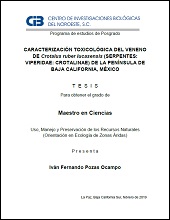Caracterización toxicológica del veneno de Crotalus ruber lucasensis (serpentes: viperidae: crotalinae) de la península de Baja California, México
Author
IVAN FERNANDO POZAS OCAMPO
Metadata
Show full item recordAbstract
"Las serpientes pertenecientes al género Crotalus se caracterizan por ser venenosas. Su veneno está compuesto por una variedad de proteínas que actúan sobre los tejidos, además de afectar la cascada de coagulación. Su composición y toxicidad varía entre especies, entre poblaciones de una misma especie, entre juveniles y adultos y entre diferentes generaciones. Estas diferencias en la composición de los venenos, abren posibilidades médicas y biotecnológicas para su aprovechamiento, con el fin de obtener a partir de ellos nuevos fármacos. Así mismo, a través de análisis biológicos y bioquímicos se puede identificar la toxicidad y efecto de los venenos de diferentes especies, con el fin de un mejor tratamiento en el accidente ofídico en humanos. El objetivo del presente estudio, fue identificar si existía variación bioquímica y biológica en el veneno de Crotalus ruber lucasensis en tres ecorregiones de Baja California Sur, haciendo también una comparación con la subespecie C. r. ruber. Se capturaron 14 serpientes (8 hembras y 6 machos), de las cuales se extrajeron muestras de veneno. Los machos presentaron mayores tallas así como mayores cantidades de veneno en peso seco. Se prepararon diferentes diluciones con mezclas de veneno por ecorregión (pools) y venenos de serpientes individuales, con las cuales, se realizaron pruebas bioquímicas como perfiles en geles de poliacrilamida y la determinación de la actividad de Fosfolipasas A2 (PLA2); así también se efectuaron pruebas biológicas como la Dosis Hemorrágica Mínima (DHM) y Dosis Edemática Mínima (DEM; ambas únicamente realizadas con pools) empleando como modelo murino, ratones de laboratorio de la cepa NIH(CD-1), asimismo se calcularon las Dosis Desfibrinante Mínima (DDM) y Dosis Procoagulante Mínima (DPM) donde se utilizaron componentes sanguíneos humanos. No se identificaron grandes diferencias entre los perfiles bioquímicos en de los venenos, siendo las metaloproteasas los componentes más abundantes, lo cual se vio relacionado con la alta actividad hemorrágica, que resultó ser la más importante del veneno de esta especie, dado que no presentaron diferencias significativas entre las ecoregiones y/o subespecies, en cambio la actividad de Fosfolipasas A2 fue la que mostró una mayor variación donde se encontraron diferencias por sexo y tamaño de la serpiente, donde las serpientes de mayor tamaño mostraron una mayor actividad." "Snakes belonging to the genus Crotalus are characterized for being poisonous. Its venom is composed of a variety of proteins that act on tissues; also activating the clotting cascade. Its composition and toxicity varies from species, population of the same species, age and different generations. These differences open medical and biotechnological possibilities for their use, in order to obtain new drugs from them. Likewise, through biological and biochemical analysis, the venom’s toxicity and effect of different species can be identified, in order to enhance treatments on the ophidic accident in humans. The objective of this study was to identify if there was biochemical and biological variation in the venom of Crotalus ruber lucasensis of three ecoregions of Baja California Sur, also making a comparison with the subspecies C. r. ruber. 14 snakes (8 females and 6 males) were captured, from which samples of venom were extracted. The males had larger sizes as well as greater amounts of venom in dry weight. Different dilutions were prepared with mixtures of venom by eco-region (pools) and venom of individual snakes. Biochemical tests were performed as profiles in polyacrylamide gels and the determination of the activity of Phospholipases A2 (PLA2). Also, biological tests like Minimum Hemorrhagic Dose (DHM) and Minimum Edema-forming Dose (DEM) were calculated both using laboratory mice NIH (CD-1) as murine model and pools of venom as well as Minimum Defibrinogen Dose (DDM) and Minimum Procoagulant Dose (DPM), both using human blood components. No large differences were identified between the biochemical profiles of the venoms, being the metalloproteases the most abundant components, which ware related to the high hemorrhagic activity, which turned out to be the most important of the venom of this species, given that there were no significant differences between the ecoregions and / or subspecies. On the other hand, the activity of Phospholipases A2 was the one that showed the greatest variation where differences were found by sex and size of the snake, where the larger snakes showed greater activity."
Collections
Related items
Showing items related by title, author, creator and subject.
-
PROMOCIÓN DEL PERIFITON PARA EL CULTIVO DE CAMARÓN BLANCO: HACIA UNA ACUICULTURA ECOLÓGICA
DOMENICO VOLTOLINA LOBINA; JUAN MANUEL AUDELO NARANJO; MARIA DEL ROSARIO PACHECO MARGES -
Suelo y Erosión
YOLANDA LOURDES MAYA DELGADO


